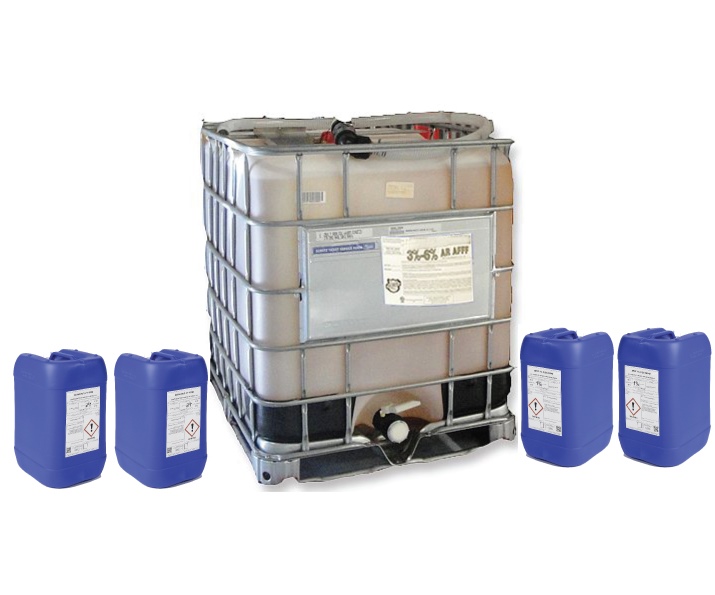Foam Concentrates
CHEMGUARD's concentrate portfolio provides foam solutions for a wide range of firefighting challenges, including industrial, marine, mining, municipal, oil, petrochemical, aviation and transportation. CHEMGUARD concentrates are approved, registered, qualified or otherwise meet the requirements of a wide range of industry specifications and standards, including:
- UL 162
- EN1568-2008
- UL 139
- USDA/USFS Spec 307a
- ULC S560
Our Class B and Class A foams, wetting agents, high-expansion foam concentrates and protein foams can be used with most standard industrial exhaust devices and systems. They are suitable for fixed proportional system applications, ground and air attack, and compressed air foam system (CAFS) use.
Redefining Performance
For decades, Aqueous Film-Forming Foams (AFFF) containing fluorochemicals have set the performance standard for Class B fire and vapor suppression. More recently the industry has expanded its foam concentrate offerings to include non-fluorinated products for Class B fuel fires, with formidable challenges to deliver AFFF-like efficacy.
Setting New Standards
Introducing UL201's patent-pending CHEMGUARDNFF 3×3 foam concentrate technology that sets a new standard for Class B fire suppression:
- Independent, third-party verified to achieve the same level of application as UL 162 listed Alcohol Resistant Aqueous Film Forming Foam for controlling and extinguishing hydrocarbon fuel fires
- Effective control and suppression of hydrocarbon fuel fires with expansion ratios as low as 3 to 1 - supports the use of standard, non-aspirated and hand line nozzles for many applications
- Similar viscosity to quality AR-AFFF 3×3, enabling applications with most properly calibrated proportions
- and discharge response devices and reduce the need for significant hardware changes
- Class-leading cross-functional performance for fire knockdown and control; durable foam blanket for longer post-extinguishing burnback resistance and vapor suppression
- Flexible response with 3% proportion in fresh, brackish or salt water for hydrocarbon and polar solvent Class B hazards
CHEMGUARD NFF 3×3 UL201 firefighting foam concentrate is UL listed with various CHEMGUARD bladder tanks, proportioners, nozzles and other discharge devices. Consult the UL listing for full details.
This foam is perfect for use in applications such as:
- Respons Kota dan Industri untuk tumpahan dan bahaya Tipe III skala terbatas
- Sistem busa dengan perangkat pelepasan Tipe II
CHEMGUARD NFF 3×3 UL201 concentrate is defined as a non-fluorinated firefighting foam concentrate, manufactured in equipment free from the use of PFAS chemicals. As this product is free from intentionally added PFAS chemicals and precautions have been taken to avoid PFAS contamination, it inherently complies with Directives (EU) 2017/1000 on PFOA and 2019/1021 (EU POPs Directive) as a non-fluorinated product.
Industry Leading Performance
Like all non-fluorinated firefighting foam concentrates, CHEMGUARD NFF 3×3 UL201 foam concentrate is UL 162 tested and listed as a Synthetic Foam. As per this UL standard, the minimum design application rate for this foam is 0.16 gpm/ft2 (6.5 lpm/m2) for Type III hydrocarbon fuel fires.
| CHEMGUARD Foam Application Rate NFF 3×3 UL201 gpm/ft2 (lpm/m2) | ||||
| UL 162 Test Protocol for Type III Hydrocarbons - Forced Application | Hydrocarbon Fuels | Premium Gasoline Fuel | ||
| Test Level | Minimum Design Level | Test Level | Minimum Design Level | |
| UL 162 Synthetic Foam Test | 0.06 (2.4) | 0.16 (6.5) | ||
| UL 162 AFFF Test (Witnessed by an Independent Third Party) | 0.04 (1.6) | 0.10 (4.1) | 0.06 (2.4) | 0.16 (6.5) |
In addition to the Synthetic Foam listing, it passed - under an independent third-party witness - the much more challenging UL 162 Type III test protocol for AFFF. This protocol uses a foam application test rate of 0.04 gpm/ft2 (1.6 lpm/m2), which is 33% lower than the application rate for the UL 162 Synthetic Foam test. Under this more challenging protocol, AFFFs with demonstrated performance equal to UL201's 3×3 NFF foam will achieve a minimum application design rate of 0.10 gpm/ft2 (4.1 lpm/m2) for all Type III hydrocarbon fuel fires.
NFPA 11 requires a minimum design application rate of 0.10 gpm/ft2 (4.1 lpm/m2) at hydrocarbon fuel spill fires, and 3rd party witnessed testing supports the use of CHEMGUARD NFF 3×3 UL201 concentrate at this application rate.
NFPA 11 and UL 162 require a minimum design application rate of 0.16 gpm/ft2 (6.5 lpm/m2) for non-fluorinated foam on Type III hydrocarbon fuel fires. CHEMGUARD NFF 3×3 UL201 foam has demonstrated an improved factor of safety at this required application rate with successful trial performance extinguishing Type III hydrocarbon fuel fires with a lower minimum application rate than AFFF. CHEMGUARD NFF 3×3 UL201 performs well and is UL listed with E15 and some polar solvent fuels as well.
| Foam Application Rate gpm/ft2 (lpm/m2) | |||
| CHEMGUARD NFF 3×3 UL201 FoamDaftar Aplikasi Busa Sintetis UL 162* | Test Level | Minimum Design Level | |
| Type III Hydrocarbons - Forced Application | Hydrocarbons | 0.06 (2.4) | 0.16 (6.5) |
| E15 (15% Ethanol/85% Gasoline) | 0.10 (4.1) | 0.17 (6.9) | |
| Type II Hydrocarbons - Soft Applications | Hydrocarbons | 0.06 (2.4) | 0.10 (4.1) |
| Polar Fuel Type II - Soft Application | Alcohol | 0.10 (4.1) | 0.17 (6.9) |
| Ethanol | 0.06 (2.4) | 0.10 (4.1) | |
| Ketones | 0.10 (4.1) | 0.17 (6.9) | |
| E85 (85% Ethanol/15% Gasoline) | 0.09 (3.7) | 0.15 (6.1) | |

